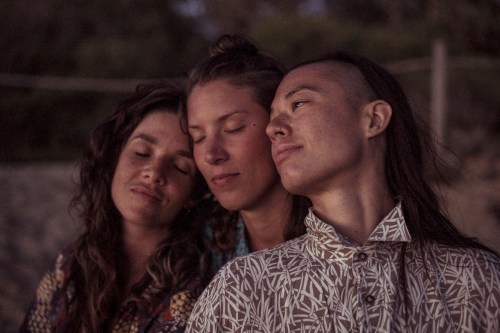Our editors independently select these products. Making a purchase through our links may earn Well+Good a commission
I’m a Sex Therapist Who’s Non-Monogamous and Polyamorous—And, No, They’re Not the Same Thing
Polyamory fits under the non-monogamy umbrella, but there's a crucial difference separating the two. Here, learn about the difference.

Non-monogamy is an umbrella term that functions as a catchall for any relationship orientation, design, or structure that is doesn’t center being romantically and sexually intimate with one person at a time. These setups include hooking up with random people, being monogamish, swinging, a friends-with-benefits framework, relationship anarchy, hierarchical non-monogamy, polyamory, polyfidelity, stranger sex, and so, so, so many more.
The point here is that non-monogamy is a general term that can take on a number of meanings. While polyamory is among those many relationship frameworks that fit under the non-monogamy umbrella, there’s a crucial difference that’s important to understand.
When you break down the word itself, the meaning of polyamory is clear: Poly means “many,” amor means “love,” adding up to the full word meaning “many loves.” With that in mind, a polyamorous relationship is a relationship where the people involved want to have or are having emotional and/or intimate, and/or sexual relationships with more than each other (with the consent of everyone involved, of course).
So, the key difference between general non-monogamy and polyamory? With polyamory, there is a level of love and perhaps commitment between however many people (beyond a single couple of two) are involved. And with non-monogamy, a need—any need—is getting met by more than one person.
How to identify a non-monogamous relationship
Just because a key characteristic of polyamorous relationships tends to include a level of commitment or sense of a relationship beyond just sex, that’s not to say non-monogamous relationships are only about sex. Yes, for some people it might be just about sex. But keep in mind that folks who are on the asexual spectrum and don’t crave or enjoy sex can be non-monogamous, as the distinction can refer to romantic orientation and not sexual.
No matter how you practice non-monogamy, though, it’s about agreements, autonomy, connection, and whatever you decide you want it to be—so long as there’s consent. Everyone involved is consenting, contributing, and agreeing to the guidelines put in place. It isn’t a free-for-all, replete with lies and cheating. Just as is the case with a healthy monogamous relationship, a non-monogamous relationship is built on a foundation of understanding one another other, communication, trust, openness, and transparency.
Polyamory versus non-monogamy: What’s the key difference?
A polyamorous relationship is the practice of having intimate, emotional, and sexual relationships with more than one person, with the consent of all involved. Polyamorous people may have a commitment to more than one person they are in a relationship with. It can also look like a committed couple inviting a third partner into their relationship, who would be considered secondary to the primary lovers. It is not just about sex; it is also about emotional connection and developing romantic relationships.
[Polyamory] is not just about sex; it is also about emotional connection and developing romantic relationships.
I consider myself to be both non-monogamous and polyamorous, and here’s why: I have three partners with whom I live, love, and want to do life. We are polyamorous. I have other relationships and play partners, but I am not in love with them—these are my non-monogamous relationships. Because I am in love with more than one person and have that capacity, I do consider myself to be polyamorous, even though a number of my external relationships do not involve falling in love and are, thus, better characterized as non-monogamous.
“What can complicate things are folks who identify as polyamorous, yet are only romantically involved with one person. These people claim the poly label because they want to make it clear that they are open to the idea of loving more than one person at a time—and so, too, are their partners,” says sex columnist and author of BoySlut, Zachary Zane. “They may also be actively dating other individuals; however, at the present moment, they’re currently only in a serious relationship with one person.”
Words matter but ultimately, it’s up to us and the other people in our relationships to agree on the meaning of these labels. There are plenty of folks who experience non-monogamy or polyamory as an orientation. For example, someone may be just as polyamorous as they are heterosexual or pansexual. Others may have their sexual orientation and then, their relationship design is a choice. So, if someone tells you that being non-monogamous or polyamorous, is just who they are, believe them. And if someone tells you that they’re not sure but would love to try, believe them.
If you align with the term polyamory but it means something different to you than “many loves,” that’s okay. Just make sure that the people around you understand that so when you describe yourself as being polyamorous, they know what you’re talking about and can understand.
By definition, polyamory is one form of non-monogamy that typically involves the practice, or capacity for, multiple romantic relationships. No matter what it means to you, though, the most important part is to communicate it and create agreements with your partner(s).
Sign Up for Our Daily Newsletter
Get all the latest in wellness, trends, food, fitness, beauty, and more delivered right to your inbox.
Got it, you've been added to our email list.










